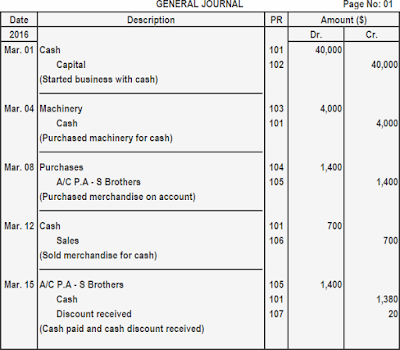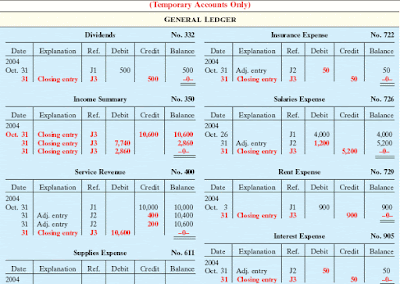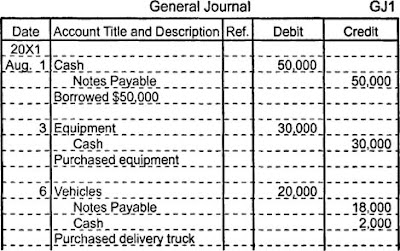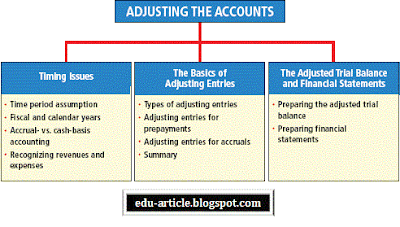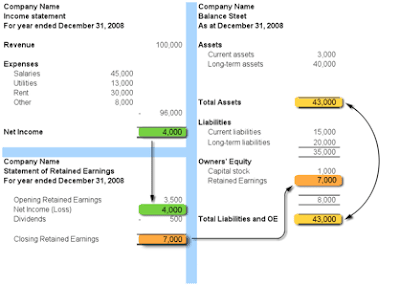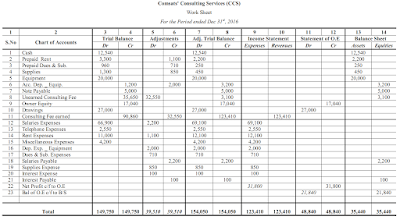Attribution. Powered by Blogger.
Friday, June 08, 2018
Thursday, June 07, 2018
DEBITS (ឥណពន្ធ) AND CREDITS (ឥណទាន)
 |
| ឥណពន្ធ មានកន្លែងផ្ទុយគ្នាពី ឥណទាន Debits # Credits (Position) |
 |
| ចំនួនទឹកប្រាក់ឥណពន្ធស្មើរនឹងឥណទាន Debits = Credits (Amounts) |
និយមន៏យនៃ ឥណពន្ធ និងឥណទាន (Debit and Credit Definitions)
ប្រតិបត្តិការអាជីវកម្មគឺជាព្រឹត្តិការណ៍ដែលមានផលប៉ះពាល់លើរបាយការណ៍ហិរញ្ញវត្ថុរបស់ស្ថាប័ន។ នៅពេលគណនាប្រតិបត្តិការទាំងនេះយើងកត់ត្រាលេខជាពីរគណនីដែលជួរឈរឥណពន្ធស្ថិតនៅខាងឆ្វេង ហើយជួរឈរឥណទានស្ថិតនៅខាងស្តាំ។(Business transactions are events that have a monetary impact on the financial statements of an organization. When accounting for these transactions, we record numbers in two accounts, where the debit column is on the left and the credit column is on the right.)
- ឥណពន្ធគឺជាគណនេយ្យដែលកត់ត្រាបង្កើនគណនីទ្រព្យសកម្ម ឬគណនីចំណាយ ឬកាត់បន្ថយ គណនីបំណុល ឬគណនីមូលធន។ វាត្រូវបានដាក់ទៅខាងឆ្វេងនៅក្នុងធាតុគណនេយ្យមួយ។(A debit is an accounting entry that either increases an asset or expense account, or decreases a liability or equity account. It is positioned to the left in an accounting entry.)
- ឥណទានគឺជាគណនេយ្យដែលកត់ត្រាបង្កើនគណនីបំណុល ឬគណនីមូលធន ឬបន្ថយទ្រព្យសកម្ម ឬគណនីចំណាយ។ វាត្រូវបានដាក់ទៅខាងស្ដាំនៅក្នុងធាតុគណនេយ្យមួយ។ (A credit is an accounting entry that either increases a liability or equity account, or decreases an asset or expense account. It is positioned to the right in an accounting entry.)
ការប្រើឥណពន្ធ និងឥណទាន (Debit and Credit Usage)
នៅពេលដែលប្រតិបត្តិការគណនេយ្យមួយត្រូវបានបង្កើតយ៉ាងហោចណាស់គណនីពីរតែងតែរងផលប៉ះពាល់ដោយធាតុឥណពន្ធត្រូវបានកត់ត្រាទល់នឹងគណនីមួយហើយធាតុឥណទានដែលត្រូវបានកត់ត្រាទុកប្រឆាំងនឹងគណនីផ្សេងទៀត។ មិនមានដែនកំណត់ខាងលើចំពោះចំនួនគណនីដែលពាក់ព័ន្ធនឹងប្រតិបត្តិការទេ - ប៉ុន្តែអប្បបរមាមិនតិចជាងគណនីពីរទេ។ ចំនួនទឹកប្រាក់សរុបនៃឥណពន្ធនិងឥណទានសម្រាប់ប្រតិបត្តិការណាមួយត្រូវតែស្មើគ្នាជានិច្ច ដូច្នេះប្រតិបត្តិការគណនេយ្យតែងតែត្រូវបានគេនិយាយថាមានតុល្យភាព។ ប្រសិនបើប្រតិបត្តិការមិនមានតុល្យភាពនោះវាមិនអាចបង្កើតរបាយការណ៍ហិរញ្ញវត្ថុទេ។ ដូចនេះការប្រើរបស់ឥណពន្ធ និងឥណទាននៅក្នុងទម្រង់កត់ត្រាប្រតិបត្តិការចំនួនពីរជួរគឺមានសារៈសំខាន់បំផុតក្នុងការគ្រប់គ្រងទាំងអស់លើភាពត្រឹមត្រូវគណនេយ្យ។
Whenever an accounting transaction is created, at least two accounts are always impacted, with a debit entry being recorded against one account and a credit entry being recorded against the other account. There is no upper limit to the number of accounts involved in a transaction - but the minimum is no less than two accounts. The totals of the debits and credits for any transaction must always equal each other, so that an accounting transaction is always said to be "in balance." If a transaction were not in balance, then it would not be possible to create financial statements. Thus, the use of debits and credits in a two-column transaction recording format is the most essential of all controls over accounting accuracy.
វាអាចមានការយល់ច្រឡំសន្ធឹកសន្ធាប់អំពីអត្ថន័យដែលមានស្រាប់នៃឥណពន្ធ ឬឥណទាន។ ឧទាហរណ៍ប្រសិនបើអ្នកដាក់ប្រាក់លើគណនីសាច់ប្រាក់នោះមានន័យថាចំនួនទឹកប្រាក់ដែលមាននៅក្នុងដៃកើនឡើង។ ទោះជាយ៉ាងណាក៏ដោយ ប្រសិនបើអ្នកឥណពន្ធនៃគណនីត្រូវបង់ មានន័យថាចំនួនគណនីដែលត្រូវបង់ត្រូវថយចុះ។ ភាពខុសគ្នាទាំងនេះកើតឡើងដោយសារតែឥណពន្ធ និងឥណទានមានផលប៉ះពាល់ខុសៗគ្នាលើប្រភេទគណនីធំ ៗ ជាច្រើនដែលរួមមាន: (There can be considerable confusion about the inherent meaning of a debit or a credit. For example, if you debit a cash account, then this means that the amount of cash on hand increases. However, if you debit an accounts payable account, this means that the amount of accounts payable liability decreases. These differences arise because debits and credits have different impacts across several broad types of accounts, which are:)
- គណនីទ្រព្យគឺ ឥណពន្ធកើន និងឥណទានថយចុះ។ (Asset accounts. A debit increases the balance and a credit decreases the balance.)
- គណនីបំណុល គឺឥណពន្ធថយចុះ និងឥណទានកើន។ (Liability accounts. A debit decreases the balance and a credit increases the balance.)
- គណនីមូលធន គឺឥណពន្ធថយចុះ និងឥណទានកើន។ (Equity accounts. A debit decreases the balance and a credit increases the balance.)
មូលហេតុនៃការមើលរំលងចំពោះការប្រើប្រាស់ឥណពន្ធ និងឥណទាននេះគឺដោយសារតែសមីការ គណនេយ្យដែលនៅពីក្រោយរចនាសម្ព័ន្ធទាំងមូលនៃប្រតិបត្តិការគណនេយ្យត្រូវបានបង្កើតឡើងដែលជា: (The reason for this seeming reversal of the use of debits and credits is caused by the underlying accounting equation upon which the entire structure of accounting transactions are built, which is:)
គណនីទ្រព្យ = គណនីបំពុល + គណនីមូលធន
Assets = Liabilities + Equity
Assets = Liabilities + Equity
ដូច្នេះក្នុងន័យមួយអ្នកអាចមានទ្រព្យតែប៉ុណ្ណោះប្រសិនបើអ្នកបានបង់ឱ្យពួកគេនូវបំណុល ឬមូលធនដូច្នេះអ្នកត្រូវតែមានមួយដើម្បីទទួលបាន។ ដូច្នេះប្រសិនបើអ្នកបង្កើតប្រតិបត្តិការជាមួយឥណពន្ធ និងឥណទានអ្នកជាទូទៅបង្កើនទ្រព្យសកម្មខណៈពេលដែលបង្កើនបំណុល ឬគណនីមូលធន (ឬផ្ទុយមកវិញ) ។ មានការលើកលែងមួយចំនួន ដូចជាការបង្កើនគណនីទ្រព្យមួយក្នុងពេលកំពុងបន្ថយគណនីទ្រព្យផ្សេងទៀត។(Thus, in a sense, you can only have assets if you have paid for them with liabilities or equity, so you must have one in order to have the other. Consequently, if you create a transaction with a debit and a credit, you are usually increasing an asset while also increasing a liability or equity account (or vice versa). There are some exceptions, such as increasing one asset account while decreasing another asset account.)
ប្រសិនបើអ្នកមានការព្រួយបារម្ភច្រើនជាងគណនីដែលបង្ហាញនៅលើរបាយការណ៍លទ្ធផលនោះវិធានការបន្ថែមទាំងនេះនឹងអនុវត្ត:(If you are more concerned with accounts that appear on the income statement, then these additional rules apply:)
- គណនីចំណូលគឺ ឥណពន្ធថយចុះ និងឥណទានកើនឡើង (Revenue accounts. A debit decreases the balance and a credit increases the balance.)
- គណនីចំណាយគឺ ឥណពន្ធកើនឡើង និងឥណទានថយចុះ (Expense accounts. A debit increases the balance and a credit decreases the balance.)
- គណនីចំណេញ គឺឥណពន្ធថយចុះ និងឥណទានកើនឡើង (Gain accounts. A debit decreases the balance and a credit increases the balance.)
- គណនីខាត គឺឥណពន្ធកើនឡើង និងឥណទានថយចុះ (Loss accounts. A debit increases the balance and a credit decreases the balance.)
ប្រសិនបើអ្នកពិតជាមានការយល់ច្រឡំអំពីបញ្ហាទាំងនេះមែននោះសូមចាំថាឥណពន្ធតែងតែស្ថិតនៅក្នុងជួរឈរខាងឆ្វេង ហើយឥណទានតែងតែចូលទៅក្នុងជួរឈរខាងស្តាំ។ មិនមានករណីលើកលែងទេ។ (If you are really confused by these issues, then just remember that debits always go in the left column, and credits always go in the right column. There are no exceptions.)
ច្បាប់ឥណពន្ធ និងឥណទាន (Debit and Credit Rules)
ច្បាប់គ្រប់គ្រងការប្រើប្រាស់ឥណពន្ធ និងឥណទានមានដូចខាងក្រោម: (The rules governing the use of debits and credits are as follows:)
- គណនីទាំងអស់ដែលជាធម្មតាមានសមតុល្យឥណាយិកនឹងបង្កើនចំនួនទឹកប្រាក់នៅពេលដែលឥណពន្ធ (ជួរឈរខាងឆ្វេង) ត្រូវបានបន្ថែមទៅពួកគេ ហើយកាត់បន្ថយនៅពេលដែលឥណទានត្រូវបានបន្ថែមទៅពួកគេ។ ប្រភេទគណនីដែលច្បាប់នេះអនុវត្តគឺគណនីចំណាយ គណនីទ្រព្យ និងគណនីភាគលាភ។ (All accounts that normally contain a debit balance will increase in amount when a debit (left column) is added to them, and reduced when a credit (right column) is added to them. The types of accounts to which this rule applies are expenses, assets, and dividends.)
- គណនីទាំងអស់ដែលជាធម្មតាមានសមតុល្យឥណទាយីនឹងបង្កើនចំនួនទឹកប្រាក់នៅពេលដែលឥណទាន(ជួរឈរខាងស្តាំ)ត្រូវបានបន្ថែមទៅពួកគេ ហើយត្រូវបានកាត់បន្ថយនៅពេលដែលមានការកត់សំគាល់ឥណពន្ធ (ជួរឈរខាងឆ្វេង) ត្រូវបានបន្ថែមទៅពួកគេ។ ប្រភេទគណនីដែលច្បាប់នេះអនុវត្តគឺគណនីបំណុល គណនីចំណូល និងគណនីមូលធន។ (All accounts that normally contain a credit balance will increase in amount when a credit (right column) is added to them, and reduced when a debit (left column) is added to them. The types of accounts to which this rule applies are liabilities, revenues, and equity.)
- ចំនួនទឹកប្រាក់សរុបនៃឥណពន្ធត្រូវតែស្មើរនឹង ចំនួនទឹកប្រាក់សរុបនៃឥណទាននៅក្នុងប្រតិបត្តិការ។ បើមិនដូច្នោះទេប្រតិបត្ដិការគណនេយ្យត្រូវបានគេនិយាយថាមិនមានតុល្យភាពហើយនឹងមិនត្រូវបានទទួលយកដោយកម្មវិធីគណនេយ្យឡើយ។ (The total amount of debits must equal the total amount of credits in a transaction. Otherwise, an accounting transaction is said to be unbalanced, and will not be accepted by the accounting software.)
ឥណពន្ធ និងឥណទានក្នុងប្រតិបត្តិការគណនេយ្យធម្មតា(Debits and Credits in Common Accounting Transactions)
ចំណុចសំខាន់ដូចខាងក្រោមកត់សំគាល់ការប្រើប្រាស់ឥណពន្ធ និងឥណទាននៅក្នុងប្រតិបត្តិការជំនួញសាមញ្ញបន្ថែមៈ (The following bullet points note the use of debits and credits in the more common business transactions:)
- Sale for cash: Debit the cash account | Credit the revenue account
- Sale on credit: Debit the accounts receivable account | Credit the revenue account
- Receive cash in payment of an account receivable: Debit the cash account | Credit the accounts receivable account
- Purchase supplies from supplier for cash: Debit the supplies expense account | Credit the cash account
- Purchase supplies from supplier on credit: Debit the supplies expense account | Credit the accounts payable account
- Purchase inventory from supplier for cash: Debit the inventory account | Credit the cash account
- Purchase inventory from supplier on credit: Debit the inventory account | Credit the accounts payable account
- Pay employees: Debit the wages expense and payroll tax accounts | Credit the cash account
- Take out a loan: Debit cash account | Credit loans payable account
- Repay a loan: Debit loans payable account | Credit cash account
Wednesday, June 06, 2018
An invoice indicates that a buyer owes money to a seller.
The Invoice has 2 factors
1. Invoice for Expense is a seller’s point of view, an invoice for the sale of goods and/or service is called a sales invoice.
2. Invoice for Income is a buyer’s point of view, an invoice for the cost of goods and/or services rendered is called a purchase invoice.
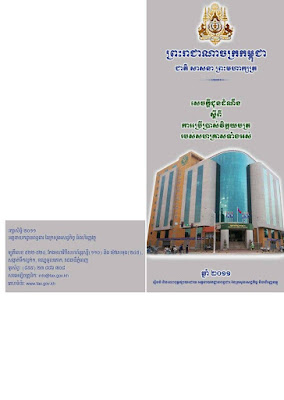


The sample Invoice has 2:
- Normal Invoice
- Tax Invoice
1. វិក្កយបត្រធម្មតា (Normal Invoice ( Not VAT))
2. វិក្កយបត្រអាករ (Tax Invoice)



- Normal Invoice
- Tax Invoice
1. វិក្កយបត្រធម្មតា (Normal Invoice ( Not VAT))
 |
| Normal Invoice |
 |
| Ex. Tax Invoice |
 |
| Sample Tax Invoice |
អាករលើតម្លៃបន្ថែមគឺ អាករយកទៅលើផលិតផលដែលត្រូវមានទិញ និងលក់រវាងក្រុមហ៊ុនចុះបញ្ជីការដូចគ្នា។
អាករលើតម្លៃបន្ថែមចេញជា ពីរប្រភេទ គឺ
១. អាករលើធាតុចូល (VAT Input) show in Expense Invoices
២. អាករលើធាតុចេញ (VAT Output) show in Income Invoices
អត្រាអាករលើតម្លៃបន្ថែមមានៈ
១០% សម្រាប់ការនាំចូលឬការផ្គត់ផ្គង់ទំនិញឬសេវាក្នុងព្រះរាជាណាចក្រកម្ពុជា
០% សម្រាប់ការនាំចេញ
០% សម្រាប់ការនាំចេញ
ការបង់ពន្ធអាករលើតម្លៃបន្ថែម (VAT Payment)
VAT Payment = VAT Output - VAT Input (if VAT Output > VAT Input)
VAT CCF = VAT Output - VAT Input (if VAT Output < VAT Input)
(Note: VAT CCF = Value Added Tax Credit Carry Forwards)
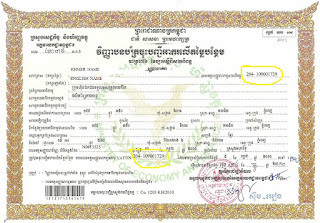
អ្នកជាប់ពន្ធតាមរបបស្វ័យប្រកាសដែលធ្វើការផ្គត់ផ្គង់ជាប់អាករ ត្រូវមានកាតព្វកិច្ចចុះបញ្ជីអាករលើតម្លៃបន្ថែម និងប្រមូលអាករលើតម្លៃបន្ថែមលើការផ្គត់ផ្គង់ទំនិញឬសេវាឱ្យអតិថិជន។
ទំនិញ សំដៅដល់ទ្រព្យរូបី ក្រៅពីដីធ្លីនិងប្រាក់កាស រីឯសេវា សំដៅដល់ការផ្តល់អ្វីមួយដែលមានតម្លៃ ក្រៅពីទំនិញ ដីធ្លី និងប្រាក់កាស។
ការផ្គត់ផ្គង់ជាប់អាករសំដៅដល់ៈ
ការផ្គត់ផ្គង់ទំនិញឬសេវាដោយបុគ្គលជាប់អាករនៅក្នុងព្រះរាជាណាចក្រកម្ពុជា
ការដកយកទំនិញមកប្រើប្រាស់ផ្ទាល់ខ្លួនដោយបុគ្គលជាប់អាករ
ការផ្តល់ជាអំណោយឬការផ្គត់ផ្គង់ក្រោមតម្លៃពិត នូវទំនិញឬសេវាដោយបុគ្គលជាប់អាករ
ការនាំចូលទំនិញមកក្នុងតំបន់ត្រួតពិនិត្យគយនៃព្រះរាជាណាចក្រកម្ពុជា
ការផ្គត់ផ្គង់មិនជាប់អាករមានដូចតទៅៈ
សេវាប្រៃសណីយ៍សាធារណៈ សេវារបស់មន្ទីរពេទ្យនិងគ្លីនិក សេវាខាងវេជ្ជសាស្រ្តនិងទន្តសាស្រ្តនិងការលក់ទំនិញបន្ទាប់បន្សំខាងវេជ្ជសាស្រ្ត និងទន្តសាស្រ្តដែលទាក់ទិននិងការបំពេញសេវាទាំងនេះ
សេវាដឹកជញ្ជូនអ្នកដំណើរដោយប្រព័ន្ធដឹកជញ្ជូនសាធារណៈដែលជាកម្មសិទ្ធិទាំងស្រុងរបស់រដ្ឋ
សេវាធានារ៉ាប់រង សេវាជាមូលដ្ឋានខាងហិរញ្ញវត្ថុដែលត្រូវកំណត់ដោយប្រកាសរបស់ក្រសួងសេដ្ឋកិច្ច និងហិរញ្ញវត្ថុ ការនាំចូលសម្ភារៈប្រើប្រាស់ផ្ទាល់ខ្លួនដែលរួចពន្ធគយ ក្នុងកម្រិតតម្លៃដែលត្រូវកំណត់ដោយប្រកាសរបស់ក្រសួង សេដ្ឋកិច្ច និងហិរញ្ញវត្ថុ សកម្មភាពមិនស្វែងរកចំណេញដើម្បីបំរើផលប្រយោជន៍សាធារណៈ ដែលបានទទួលស្គាល់ដោយរដ្ឋមន្រ្តីក្រសួង សេដ្ឋកិច្ច និងហិរញ្ញវត្ថុ
ការនាំចូលនិងការទិញទំនិញសម្រាប់ឬដោយបេសកកម្មទូតនិងកុងស៊ុលបរទេសអង្គការអន្តរជាតិ និងទីភ្នាក់ងារ សហប្រតិបត្តិការបច្ចេកទេសរបស់រដ្ឋាភិបាលនានា សម្រាប់យកមកប្រើនៅក្នុងការបំពេញមុខងារជាផ្លូវការរបស់ខ្លួន
អត្រាអាករលើតម្លៃបន្ថែមមានៈ
១០% សម្រាប់ការនាំចូលឬការផ្គត់ផ្គង់ទំនិញឬសេវាក្នុងព្រះរាជាណាចក្រកម្ពុជា
០% សម្រាប់ការនាំចេញ
ការគណនាប្រាក់អាករត្រូវបង់ៈ
ប្រាក់អាករដែលបានបង់នៅពេលនាំចូលទំនិញ ឬប្រាក់អាករដែលបានបង់លើការទិញទំនិញ ឬសេវា សម្រាប់ ប្រកបអាជីវកម្ម ហៅថា "អាករលើធាតុចូល" ប្រាក់អាករដែលបានគិតយកពីអតិថិជនពីការផ្គត់ផ្គង់ទំនិញ ឬសេវាហៅថា "អាករលើធាតុចេញ" ប្រាក់អាករត្រូវបង់ = អាករលើធាតុចេញ - អាករលើធាតុចូល
អាករលើធាតុចូលដែលមិនអាចកាត់កងបានៈអាករលើធាតុចូលដែលមិនអាចកាត់កងបានរួមមានប្រាក់អាករដែលបានបង់លើៈ ចំណាយទទួលភ្ញៀវ ការកំសាន្ត ឬការសម្រាកលំហែ លើកលែងតែបុគ្គលជាប់អាករមានអាជីវកម្មជាអ្នកផ្គត់ផ្គង់ ការទទួលភ្ញៀវ ការកំសាន្ត ឬការសម្រាកលំហែ
ការទិញឬការនាំចូលរថយន្ត លើកលែងតែបុគ្គលជាប់អាករប្រកបអាជីវកម្មជាអ្នកលក់ ឬជួលរថយន្ត ការទិញឬការនាំចូលផលិតផលតេលសិលាមួយចំនួន លើកលែងតែបុគ្គលជាប់អាករប្រកបអាជីវកម្មជាអ្នកផ្គត់ផ្គង់ ផលិតផលតេលសិលាទាំងនោះ
អ្នកជាប់ពន្ធដែលធ្វើការផ្គត់ផ្គង់ជាប់អាករនូវទំនិញឬសេវា ត្រូវទទួលខុសត្រូវក្នុងការបង់ប្រាក់អាករជូនរដ្ឋបាលសារ ពើពន្ធយ៉ាងយឺតបំផុតត្រឹមថ្ងៃទី២០ នៃខែបន្ទាប់ពីខែដែលមាន ការផ្គត់ផ្គង់។
{Value added|Useful} tax (VAT) in Cambodia works on the same {basic principles|basics} as VAT, or {goods and services|services and goods} tax (GST) used in other countries; VAT-registered businesses must apply {VAT|VALUE-ADDED TAX} on their sales and can offset the {VAT|VALUE-ADDED TAX} on their supplies used to carry out their business. {They must|They have to|They need to} then pay the excess output {VAT|VALUE-ADDED TAX} or may {obtain a|get yourself a|get a} {refund|reimbursement|return} if input VAT is greater than output {VAT|VALUE-ADDED TAX}. Note that in practice, however, {it is not|it is far from|it is not necessarily} possible to obtain a VAT {refund|reimbursement|return}.
There are only two rates of VAT in Cambodia - 10% on taxable supplies in Cambodia and 0% on taxable supplies exported out of Cambodia. Taxable supplies are made up of all supplies other than those that are exempt. {Note|Notice|Take note}: Sale of land is not subject to {VAT|VALUE-ADDED TAX}; however, sale of building and rental of land or buildings are {subject|subject matter|issue} to 10% VAT.
{The|The particular|Typically the} offsetting of input {VAT|VALUE-ADDED TAX} against output VAT is calculated in the {monthly|month-to-month|month to month} VAT return, which must be submitted by the taxpayer to the GDT by the 20th of the following month. {The|The particular|Typically the} VAT returns are {recognized|determined|discovered} by the unique Taxpayer Identification Number (TIN) which businesses obtain {after} {VAT|VALUE-ADDED TAX} registration and must use on all tax {returns|earnings|results}.
Monday, May 28, 2018
Accounting Cycle:
The accounting cycle is a methodical set of rules to ensure the accuracy and conformity of financial statements. Computerized accounting systems and the uniform process of the accounting cycle have helped to reduce mathematical errors. Today, most software fully automates the accounting cycle, which results in less human effort and errors associated with manual processing.
Cycle:
1. Invoice
1.1-Expense Invoice
1.2-Revenues Invoice
2. Journal Entries
3. Ledger Accounts
3.1-T-Account
3.2-Special Journal
4. Unadjusted Trial Balance
5. Worksheet (Adjusting Entries)
5.1-Accrual
-Accrued Expense
-Accrued Revenues
5.2-Deferral
-Prepaid Expense
-Unearned Revenues
-Depreciation
6. Financial Statement
6.1-Income Statement
6.2-Cash flow statement
6.3-Balance Sheet
7. Closing Entries
7.1-Close Revenues to Income Summary
7.2-Close Expense to Income Summary
7.3-Close Income Summary to Capital
7.4-Close Owner's Draw to Capital
8. Post Closing Trial Balance
Picture
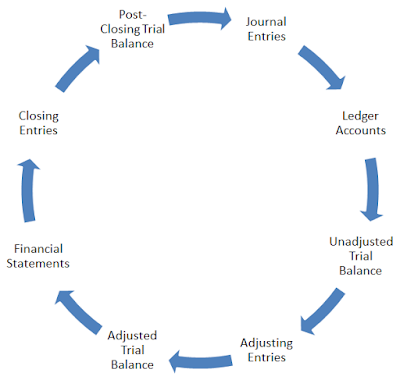 |
| Accounting Cycle |



